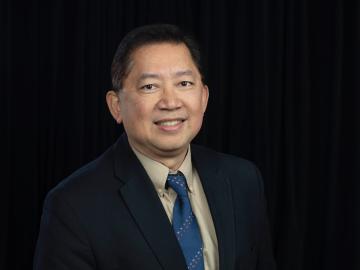Filter News
Area of Research
- Advanced Manufacturing (7)
- Biological Systems (3)
- Biology and Environment (119)
- Biology and Soft Matter (4)
- Building Technologies (3)
- Chemical and Engineering Materials (3)
- Chemistry and Physics at Interfaces (7)
- Clean Energy (208)
- Climate and Environmental Systems (7)
- Computational Biology (1)
- Computational Chemistry (5)
- Computational Engineering (2)
- Computer Science (4)
- Data (1)
- Earth Sciences (1)
- Electricity and Smart Grid (2)
- Energy Frontier Research Centers (7)
- Energy Sciences (2)
- Fuel Cycle Science and Technology (2)
- Functional Materials for Energy (10)
- Fusion and Fission (43)
- Fusion Energy (7)
- Geographic Information Science and Technology (1)
- Isotopes (24)
- Materials (186)
- Materials Characterization (2)
- Materials for Computing (17)
- Materials Synthesis from Atoms to Systems (8)
- Materials Under Extremes (8)
- National Security (53)
- Neutron Data Analysis and Visualization (2)
- Neutron Science (83)
- Nuclear Science and Technology (35)
- Quantum Condensed Matter (3)
- Quantum information Science (5)
- Renewable Energy (2)
- Sensors and Controls (2)
- Supercomputing (172)
- Transportation Systems (6)
News Type
News Topics
- 3-D Printing/Advanced Manufacturing (51)
- Advanced Reactors (12)
- Artificial Intelligence (50)
- Big Data (24)
- Bioenergy (53)
- Biology (62)
- Biomedical (32)
- Biotechnology (10)
- Buildings (22)
- Chemical Sciences (32)
- Clean Water (14)
- Climate Change (52)
- Composites (9)
- Computer Science (95)
- Coronavirus (21)
- Critical Materials (2)
- Cybersecurity (20)
- Decarbonization (45)
- Emergency (2)
- Energy Storage (43)
- Environment (113)
- Exascale Computing (26)
- Fossil Energy (4)
- Frontier (26)
- Fusion (36)
- Grid (25)
- High-Performance Computing (53)
- Hydropower (5)
- Irradiation (1)
- Isotopes (30)
- ITER (3)
- Machine Learning (22)
- Materials (70)
- Materials Science (60)
- Mathematics (5)
- Mercury (7)
- Microelectronics (2)
- Microscopy (27)
- Molten Salt (2)
- Nanotechnology (28)
- National Security (40)
- Net Zero (7)
- Neutron Science (57)
- Nuclear Energy (65)
- Partnerships (17)
- Physics (32)
- Polymers (12)
- Quantum Computing (19)
- Quantum Science (31)
- Renewable Energy (1)
- Security (13)
- Simulation (33)
- Software (1)
- Space Exploration (12)
- Summit (32)
- Sustainable Energy (48)
- Transformational Challenge Reactor (4)
- Transportation (34)
Media Contacts

A team of researchers including a member of the Quantum Science Center at ORNL has published a review paper on the state of the field of Majorana research. The paper primarily describes four major platforms that are capable of hosting these particles, as well as the progress made over the past decade in this area.

Researchers at the Department of Energy’s Oak Ridge National Laboratory met recently at an AI Summit to better understand threats surrounding artificial intelligence. The event was part of ORNL’s mission to shape the future of safe and secure AI systems charged with our nation’s most precious data.

A team led by researchers at ORNL explored training strategies for one of the largest artificial intelligence models to date with help from the world’s fastest supercomputer. The findings could help guide training for a new generation of AI models for scientific research.

When scientists pushed the world’s fastest supercomputer to its limits, they found those limits stretched beyond even their biggest expectations. In the latest milestone, a team of engineers and scientists used Frontier to simulate a system of nearly half a trillion atoms — the largest system ever modeled and more than 400 times the size of the closest competition.

Joseph Chapman, a research scientist in quantum communications at ORNL, was given the Physical Review Applied Reviewer Excellence 2024 award for his work as a peer reviewer for the journal Physical Review Applied.

ORNL researchers have teamed up with other national labs to develop a free platform called Open Energy Data Initiative Solar Systems Integration Data and Modeling to better analyze the behavior of electric grids incorporating many solar projects.

Four ORNL researchers traveled to Warsaw, Poland, during the first week of April to support the opening of Poland’s first Clean Energy Training Center, a regional hub dedicated to providing workforce development and training to expand new nuclear capacity in Central Europe.

ORNL scientists are working on a project to engineer and develop a cryogenic ion trap apparatus to simulate quantum spin liquids, a key research area in materials science and neutron scattering studies.

Rigoberto “Gobet” Advincula, a leader in advanced materials, polymers and nanomaterials with joint appointments at ORNL and the University of Tennessee, has been named to the U.S. National Academies of Sciences, Engineering and Medicine’s Board on Chemical Sciences and Technology.

Researchers at ORNL are using a machine-learning model to answer ‘what if’ questions stemming from major events that impact large numbers of people. By simulating an event, such as extreme weather, researchers can see how people might respond to adverse situations, and those outcomes can be used to improve emergency planning.




